Search the Special Collections and Archives Portal
Search Results

Transcript of interview with Dr. Porter Troutman by Claytee D. White, November 20, 2006
Date
Archival Collection
Description
Interview with Dr. Porter Troutman conducted by Claytee D. White on November 20, 2006. Active in the civil rights movement during college in the 1960s, Troutman became a teacher and later Director of National Teacher Corps, a competency-based teacher education program. His courses at UNLV focus on multicultural education.
Text
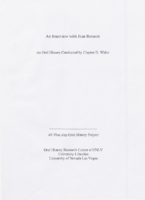
Transcript of interview with Jean Bennett by Claytee D. White, July 8, 2008
Date
Archival Collection
Description
Interview with Jean Bennett conducted by Claytee D. White on July 8, 2008. Bennett's early rock-and-roll career blossomed with music producer Buck Ram, who sold her the legal rights to the Platters in 1966. Bennett's assistant Gayle Schreiber also contributes to the interview.
Text
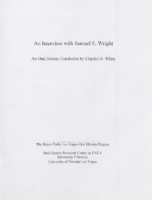
Transcript of interview with Samuel E. Wright by Claytee D. White, October 8, 2010
Date
Archival Collection
Description
Interview with Samuel E. Wright conducted by Claytee D. White on October 8, 2010. Wright candidly discusses growing up during the 1960s racial riots and notes the influence of black activist Stokely Carmichael during that era. He attended Howard University and began a career in public transportation that eventually brought him to Los Angeles and then to Las Vegas with a personal invitation from Mayor Bill Briare. Arriving in Vegas in 1979, Wright worked for the Regional Transportation Commission for twenty-six years, improving systems for a rapidly expanding city. Wright's career ignited his interest in preserving local history and neighborhoods, leading him to start a non-profit organization called PlaceMakers with Las Vegas architect Bob Fielden.
Text
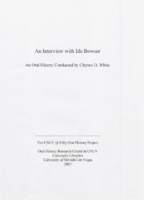
Transcript of interview with Ida Bowser by Claytee D. White, August 30, 2007
Date
Archival Collection
Description
Interview with Ida Bowser conducted by Claytee D. White on August 30, 2007. Born in Tallulah, Louisiana, Bowser came to Las Vegas as a child. Her first job after high school was as a teacher's aide. Later, she worked as a maid at the Sahara and Flamingo hotels. Disenchanted with maid's work, Bowser applied to the welfare office for on-the-job training and began working for the UNLV library, where she remained for thirty-seven years. Bowser recalls Ruby Duncan and the civil rights movement, notable individuals and places, and a discrimination lawsuit.
Text
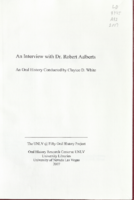
Transcript of interview with Dr. Robert Aalberts by Claytee D. White, November 16, 2006
Date
Archival Collection
Description
Text

Transcript of interview with Irwin Kishner by Claytee D. White, September 10, 2013
Date
Archival Collection
Description
Irwin Kishner (1933 ? 2017) was a noted real estate developer, attorney and longtime community leader. In this oral history interview conducted in 2013, he briefly shares his childhood growing up Jewish in Brighton Beach area of Brooklyn, New York. He often speaks of himself in the third person, as he brings to life his roots, his family?s move to Miami where he graduated from high school and the tale of his relocation to Las Vegas to work with his uncles Herman and Maury Kishner. He describes his entrance to Las Vegas as that of a bon vivant. And truly, Irwin, fell in love with the city from the moment he arrived in 1960. Irwin was a graduate of University of Florida (1954) and University of Miami Law School (1958). Both his daughters, Sharon and Joanna, were born in Las Vegas and he reminisces about becoming a Jewish bachelor father to them. In June 2013, shortly before this interview, Irwin celebrated his 80th birthday. He was a proud father, grandfather and energetic businessman who left an indelible mark on everyone he knew. As a developer, he was known for the Somerset Apartments, Somerset House Motel, Somerset Gardens apartment complex, and the Somerset Shopping Center. He enjoyed reflecting on the many community organizations he dedicated himself to, from the Las Vegas Convention and Visitors Authority to Opportunity Village to the original Las Vegas Rotary Club to the Community Concert Association?and that?s just to mention a few.
Text
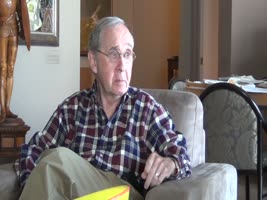
Video of interview with Arthur "Art" Marshall by Claytee D. White, February 11, 2014
Date
Archival Collection
Description
Arthur "Art" Marshall discusses early life in Las Vegas, the financing of Las Vegas casinos, and his involvement in the Jewish community.
Moving Image
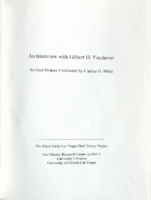
Transcript of interview with Gilbert D. Yarchever by Claytee White, 2006
Date
Archival Collection
Description
Gilbert Yarchever was one of nine siblings, born and bred in Pittsburgh, Pennsylvania. He describes the way his mother?s family was granted the last name of ?Kurfeersf" by Emperor Franz Joseph (of Austria-Hungary), explains the Seder (the Jewish observation of the exodus of Hebrews from Egypt), and tells what it was like to survive the Depression. Gilbert describes the jobs he held after high school and the government examination he took that led to his lifetime of adventure and travel. He moved to Washington, D.C., in 1940 and kept himself busy working for the government and taking classes at George Washington University, as well as working part time at Hecht Department Store and as a freelance court reporter. Following the attack on Pearl Harbor in 1941, Gilbert was sent to Africa on a merchant ship, helped smuggle Jewish survivors into Jerusalem, and was assigned the task of negotiating with Arab sheikhs for laborers to build a road. In the years after that, he worked in Europe, Panama, Alaska, Japan, and Hawaii and describes many of the jobs he was responsible for and many of the individuals he met. He also married and had children, kept up with university classes whenever he could, and collected art objects and paintings. Following his retirement in 1977, Gilbert and his family came to Las Vegas and bought a condo in Regency Towers. He did some consulting work for a couple of years, and then he and his wife began traveling around the states and going abroad. He was involved with UNLV?s EXCEL program, the music department, and the Las Vegas Art Museum. (He and his second wife Edythe presented the first major exhibition on Holocaust art at the museum.) These days Gilbert often donates pieces from his art collection to churches, synagogues, and charitable organizations.
Gilbert Yarchever was in the Navy during World War II, helped smuggle Jewish refugees into Jerusalem, worked as a civil servant in many countries, and moved to Las Vegas in 1977. He helped found the EXCEL program at University of Nevada, Las Vegas and was an art collector with his wife, Edythe Katz-Yarchever.
Text
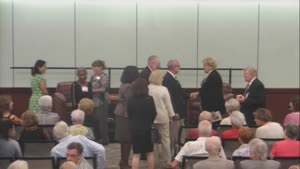
Video of interview with Carolyn and Oscar Goodman, Las Vegas (Nev.), October 18, 2014
Date
Archival Collection
Description
Carolyn and Oscar Goodman discuss their early lives, moving to Las Vegas, their definition of "community" in Las Vegas, early careers, and current Downtown economy in an interview at UNLV's Lied Library in Las Vegas, Nevada.
Moving Image
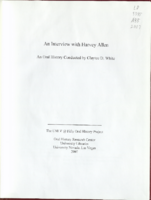
Transcript of interview with Harvey Allen by Claytee D. White, December 5, 2006
Date
Archival Collection
Description
Text
